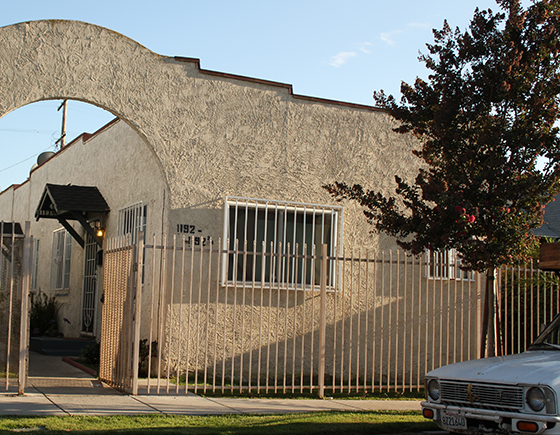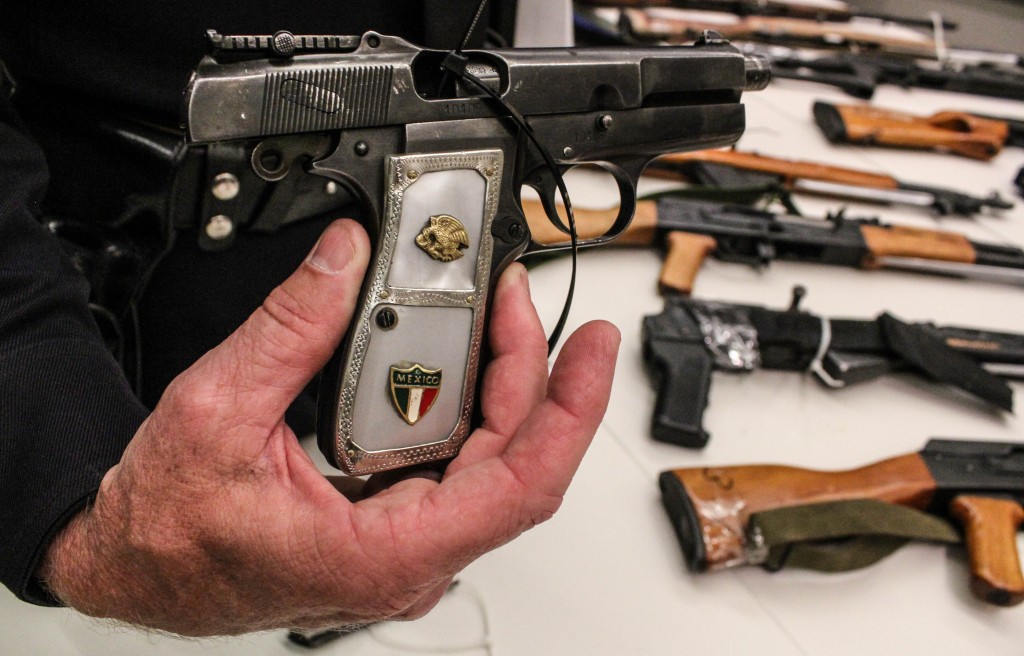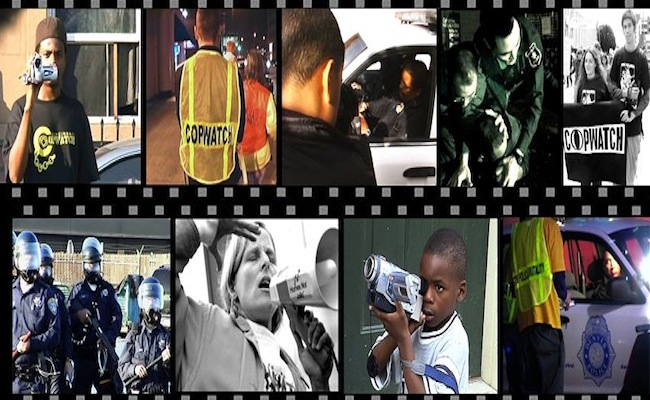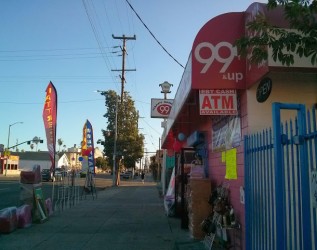When police officers arrived at a two-room apartment just south of USC last fall to investigate complaints of foul odors, they found a body decomposed beyond recognition.
Something else caught their attention, too — the black electrical cord knotted around the man’s neck.
A Los Angeles Police detective declared the apartment a crime scene and set about collecting mail, business cards, fingerprints, DNA samples — anything that might offer clues about the dead man’s life, and how and why he’d died. A driver’s license revealed a name: Stanley Thiesfield.
Almost a year later, the fact that Thiesfield died at age 59 remains one of the only conclusions of the investigation.
[Read more…]
An unexplained death in South LA
City collects 950 guns in buyback
A World War II rifle outfitted with a grenade launcher, a 9mm handgun inlaid with silver and a Mexican flag emblem, and the type of semi-automatic rifle used by the Sandy Hook gunman will soon meet the same fate: meltdown.
The Los Angeles Police Department collected 950 weapons last weekend in its eighth annual buyback program that gives Angelenos gift cards for guns, no questions asked.
See also on Intersections: Tackling gun violence in South LA
Police Chief Charlie Beck said the program intends to rid homes and streets of “unwanted” arms. [Read more…]
USC student tells of racial profiling in South LA
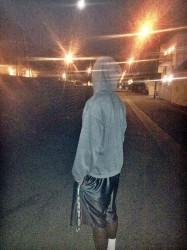
Tobi Oduguwa looks out onto the street where he said he experienced racial profiling in the area near USC. | Lensa Bogale
Tobi Oduguwa is a University of Southern California junior double-majoring in computer science and physics. But as a black man two inches over six-feet-tall, he gets asked what position he plays on basketball team more often than his major. The question comes up so often that he has given himself his own, unofficial basketball number.
“If you hear about a point-guard named number six, that’s actually me,” said Oduguwa.
But the assumptions aren’t always so harmless.
Oduguwa learned the hard way when officers from the USC Department of Public Safety stopped him one night outside of his apartment and, without explanation, asked to see his ID.
After being question, Oduguwa realized that he was suspected of choking a young woman in the building across from his own. It wasn’t until a friend vouched for Oduguwa that he was finally released. [Read more…]
Nonprofit Spotlight: Cop Watch Los Angeles (CWLA)
Intersections’ Nonprofit Spotlight series profiles South L.A. organizations that are propelling positive change in South L.A.
_________________________________________________________________________
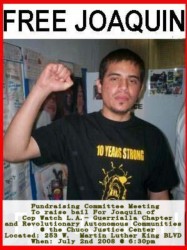
Flyer from a fundraiser to free Joaquin Ceinfuegos, the founder of Copwatch LA, from jail | Photo Courtesy of Copwatch LA
What is Cop Watch LA’s purpose? According to our mission statement,”CWLA is a program, coalition, and network dedicated to the struggle that will end police terrorism through collecting information on and observing police activity, by offering support to those caught in the criminal injustice system, fighting for change without a reformist consciousness, and working side-by-side with oppressed communities*, and grassroots organizations to create revolutionary
Suspect named in South LA 99 Cent store clerk murder
The Los Angeles Police Department’s 77th Street Homicide Division has named 31-year-old Eric Atkinson as the suspect in the robbery and murder of discount store clerk Martha Sanchez, according to a press release issued by Ninth District Councilman Curren Price’s office.
Sanchez was working as a store clerk at a local Happy Bargain 99 Cents Store on the 7400 block of South Broadway around at 8:50 p.m. on Sept.17 when the robbery and shooting happened. [Read more…]
South LA neighborhood in the aftermath of the Martha Sanchez shooting
Brenda Ramirez and her husband had finished work and were driving home when they saw police and a crowd gathered around a South Los Angeles discount store a block away from their upholstery shop.
Enrique Espino, a high school student, was sitting on his couch watching TV when he heard his neighbors run out of their homes. Eva Alvarez, who was working in her bail bond store, saw an ambulance on her store’s surveillance camera and sprinted towards the shop across the street.
Their neighbor, Martha Sanchez, had been shot. [Read more…]
Deep-seated problems at USC surface during campus forum
Standing shoulder to shoulder, looking for answers, they were not going to let anyone pass. A dozen deep and three times as wide, they stared down those on the opposing side. The seated audience separated them, but the stares from the seats were just intense. 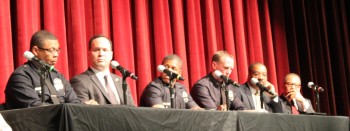
Eight stared back. It was hot. Not just from the lack of air conditioning. Hundreds of heated bodies crammed the Ronald Tutor Campus Center Ballroom. Hundreds more hoping to be let in.
A movement that began on social media showed its strength Tuesday night, May 7, during a forum about the police response to an off-campus party early Saturday morning near the University of Southern California campus. Those at the party were predominately black USC students and many were there to celebrate their upcoming graduation, party host Nate Howard said. Students are wondering why Howard’s party was shut down by the Los Angeles Police Department and why another, with mostly white students, just across the street was treated differently. The LAPD, city and university officials and black student leaders came together for the discussion and took comments from an animated crowd.
“What actions were taken to ensure student safety?” One party attendee asked. “Was it the handcuffs? Was it the intimidation?”
“You shouldn’t be upset because you were profiled incorrectly,” a recent USC graduate said. “You should be upset because you were profiled period.”
Nearly 80 LAPD officers in riot gear, at least one carrying a rifle, with a police helicopter in the sky responded to what started as a noise complaint early Saturday morning, according to videos and police reports. The first responding officer to the house near the intersection of 23rd and Hoover Street tried shutting the party down but felt threatened and called for help. Police throughout the city heard the call for help and car after car arrived at the scene. Officers from USC’s Department of Public Safety usually respond first to noise complaints in the surrounding community, but that night the call went straight to LAPD.
“In a perfect world, it would have been nice to get DPS there to handle it, but that’s not the way it happened,” Bob Green, LAPD Deputy Chief of Operations-South Bureau said in an interview.
DPS did arrive on the scene eventually. There is no indication that in the approximately hour-and-a-half between the original call to LAPD and the time they were able to respond around 2 a.m. that any communication with DPS was made.
The party across the street was just as loud and had about as many people as Howard’s party, according to attendees. Witnesses said Howard’s party was told to shut down first. Police then told the other party to turn off their music and stay inside, which they did. The situation outside Howard’s graduation party escalated.
Pictures show students holding hands, protesting against the actions of the police. Attendees said officers were disrespectful and overly aggressive. Police said some students were trying to intimidate officers, including circling an officer making an arrest. Video and audio from LAPD have not been released. Six individuals from Howard’s party were ultimately arrested and charged – four with failure to disperse and two for interfering with an officer’s investigation.
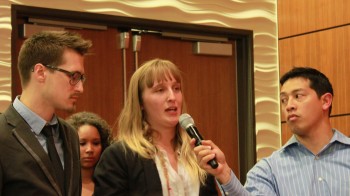
Partygoer Sarah Bowie Tither-Kaplan from across the street confronts the panel with her account of what happened.
“These students were not treated with respect,” Sarah Tither-Kaplan, an attendee of the party across the street, said at the forum. “My house was treated with respect. The only difference between the two parties was that racial component and if you’re going to deny that then I’m sorry, I’m just not going to stand for it.”
DPS Chief John Thomas was out of state that weekend. After watching video of what happened, he said he was “very disappointed” by what he saw from his officers. He said he expects DPS officers to be proactive and intervene on behalf of students when police officers confront them. Since becoming chief at the beginning of the semester, people have questioned Thomas’ decision to give his personal phone number to students. But that night students were the main way he stayed updated as DPS and LAPD supervisors dealt with the fluid situation.
“The first call I got wasn’t from DPS,” Thomas said in an interview. “It wasn’t from LAPD. It was a student at the scene who said ‘Chief Thomas, get out here. This is chaos…’ And it’s very disturbing to me to see that same student handcuffed lying on her stomach. She was talking to me and I’m thinking to myself ‘How did this happen?’”
Students and a parent at the forum asked how LAPD and DPS could be so out of sync when the organization’s senior administrators boast about a great mutual relationship. Just last spring USC President C.L. Max Nikias announced with Mayor Antonio Villaraigosa and LAPD Chief Charlie Beck that the university would be spending at least $600,000 to hire four on-campus LAPD officers. More recently this semester students have complained about LAPD officers giving out tickets for bicycle infractions when previously they had not. Many students felt the bike tickets were unnecessary and unfairly targeted USC students. Panelists suggested incidents like last Saturday’s could be prevented if law enforcement responders understood the dynamics of college life at USC.
“I think a lot of that had to do with just the posturing of position and the way the police showed up,” Thomas said. “Our students are not used to that. And I don’t want them to get used to that.”
For many in the ballroom, LAPD’s reaction was an obvious case of racial profiling and excessive force. In an opening statement at the forum, LAPD Captain Paul Snell said he did not believe at that point the police reaction Saturday morning was race-based. When Commander Bill Scott of LAPD’s South Bureau asked the audience who thought the incident was based on race, nearly every hand raised. Several speakers from the crowd compared last Saturday’s incident to the 1992 LA Riots, which were sparked after a jury acquitted one Latino and three white LAPD officers accused in the videotaped beating of Rodney King.
In 1992, the USC campus was almost completely untouched by the rioting. According to the incoming Daily Trojan editor at the time, Mike Carlson, USC remained unscathed because of good ties with the surrounding community.
“At least talking to people in the community when I was out and about I got the impression that they saw USC as an asset, an institution that was doing things for the neighborhood, for the community and so why would they really want to destroy it or hurt it in any way,” Carlson said in an interview last year.
But Thomas, the DPS Chief and a South LA native, is not so sure those strong community relationships exist anymore. He said the forum would be a waste of time if students did not begin to make better efforts to engage their neighbors.
“Our students will go to the other side of the world to make a difference,” Thomas said. “I’m just asking that they make a difference in the neighborhoods around USC. I don’t think there’s any better investment.”
One member of the community who claimed to have lived in the area since 1984 enthusiastically supported what students are calling the “USChangeMovement,” which developed in the aftermath of last Saturday’s incident. Even so, he thought the needs of non-students living in the area were not being fairly heard.
“When you’re trying to get enough sleep so you can go to work the next day and you have some young kids making noise until 3 or 4 in the morning,” the man said at the forum. “This has to stop.”
University officials do not anticipate off-campus partying to stop anytime soon. It generally costs more money to host an event on-campus than off because of facility fees and new security measures, according to student government sources. The new security policies were in response to the shooting that occurred at the Campus Center last Halloween. The measures restrict nighttime access to campus and require additional security at all campus events.
For large events, like Springfest, the new measures can cost student organizations thousands of dollars, according to members of the Undergraduate Student Government. Dr. Michael Jackson, vice president for Student Affairs, said facilities are available for on-campus social activities, but the administration and student groups need to “figure it out” when it comes to cost concerns. The forum left Jackson hopeful more progress would be made on campus through the work of students.
“In my 18 years I don’t think I’ve seen such a passionate response to a problem besides a football victory or loss and that, in some ways, is quite beautiful,” Jackson said.
The panelists all agreed that new strategies to educate officers on the dynamics of college life at USC need to be a priority. One student suggested more programs where LAPD officers interact with students in athletic events. Thomas said this party was not much different than other parties at USC. He and several others said the way an officer first interacts with the partygoers is essential in preventing another incident like last Saturday’s from occurring.
In the meantime, the message from LAPD was they are listening.
“My daughter would’ve been at that party,” Scott, the LAPD commander, said. “We had a family event over the weekend or she would’ve been at that party. She had friends at that party. We care.”
Reward money for Christopher Dorner withdrawn
The $1.2 million reward money put up for the ex-LADP officer Christopher Dorner may never actually make it into the hands of the citizens that helped with the manhunt. Click here to read more.
OPINION: We may forget Dorner, but we won’t forget the LAPD’s history
The Los Angeles Police Department (LAPD) has developed a reputation in the Los Angeles community and in the nation as one of the most brutal and corrupt police departments in the U.S., a reputation stemming from cases such as Rodney King and those involving the Rampart Division. For more of the story please click here.
9th District Candidate Closeup: Terry Hara
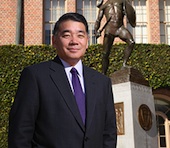 When Terry Hara was posing as an undercover cop as the real-life version of “21 Jump Street” in the 1980s, he never imagined he would make an attempt to play a new role over three decades later. As the current Los Angeles Police Department Deputy Chief, Hara believes he has what it takes to be the next Ninth District City Council member.
When Terry Hara was posing as an undercover cop as the real-life version of “21 Jump Street” in the 1980s, he never imagined he would make an attempt to play a new role over three decades later. As the current Los Angeles Police Department Deputy Chief, Hara believes he has what it takes to be the next Ninth District City Council member.
“The people want somebody that they can trust,” said Hara to a group of USC students in early February.
Hara is going back to the basics and building trust the old-fashioned way. He is knocking on doors in the community to find out what changes residents hope to see.
“There is a difference between hearing and listening,” said Hara. “In order to listen to someone who is telling a story or a problem they have in my mind I’m saying, ‘how can I problem-solve? What can I do to provide the services or response that they are looking for?’”
He hopes to help community members with the small problems such as illegal dumping, cleaning the alleyways, and repairing potholes and sidewalks. According to the Los Angeles Times, half of the illegal dumping throughout Los Angeles happens in South LA. Hara wants to ensure that the residents of South LA are allocated their fair share of services to combat these problems.
Hara also wants to deal with larger issues in the community that may not have such an obvious answer, such as unemployment. The unemployment rate in Los Angeles is about 11 percent. In some South LA neighborhoods, such as Florence, Graham and Westmont, the LA Times reports that the unemployment rate is much higher at 24 percent. Hara wants to help those who have returned to the community after serving time in prison by setting up job training programs for them.
“The people want somebody who’s a leader and not afraid to make a decision, even a hard decision,“ said Hara.
Hara also wants to combat an issue that resonates with the USC: public safety. He believes his 32 years of experience with LAPD will help him improve the safety of neighborhoods.
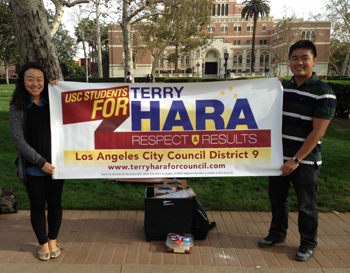 “I believe that Terry really does have the district’s best interest at heart and I wish him the best of luck with the rest of his campaign,” said Vanessa Wilkins, a sophomore undergraduate at USC.
“I believe that Terry really does have the district’s best interest at heart and I wish him the best of luck with the rest of his campaign,” said Vanessa Wilkins, a sophomore undergraduate at USC.
Hara joined LAPD in February 1980. He has had numerous positions throughout the department but is the first Asian-American to achieve the rank of Deputy Chief.
“None of the candidates come close to my experience of work and leadership in the community [for] the past three decades,” said Hara.









